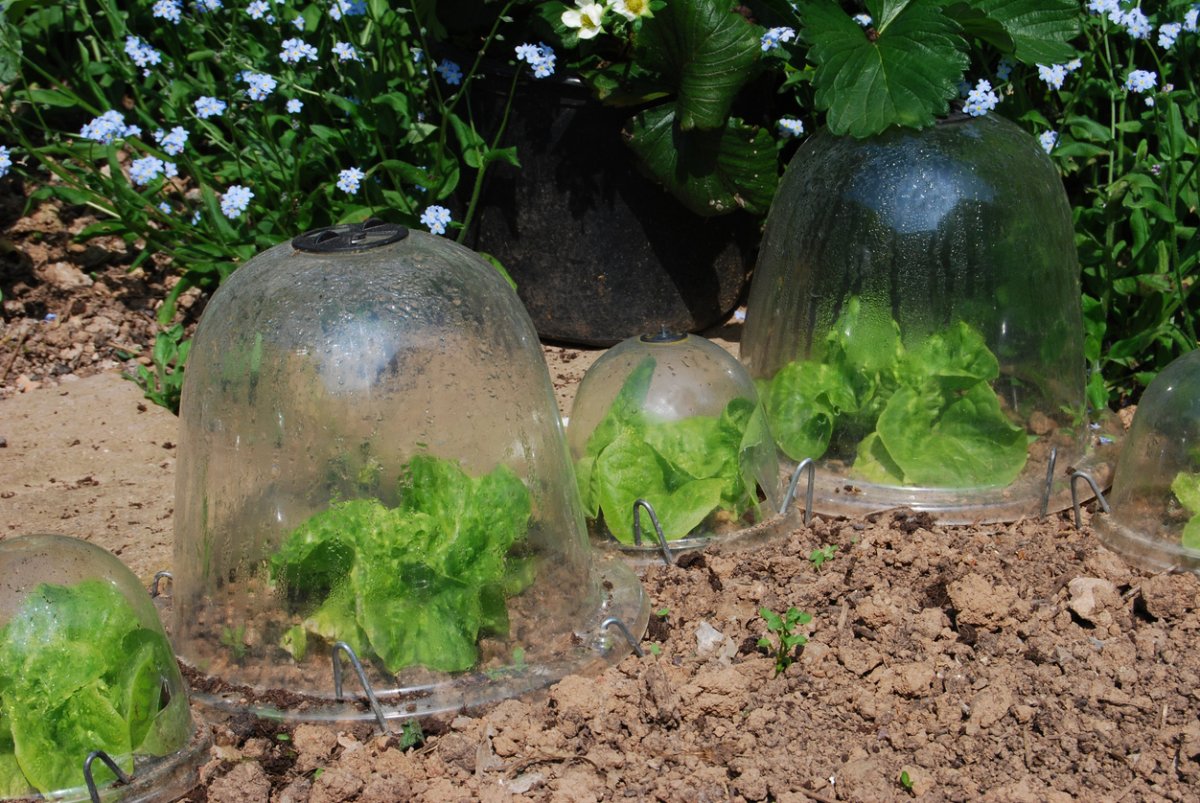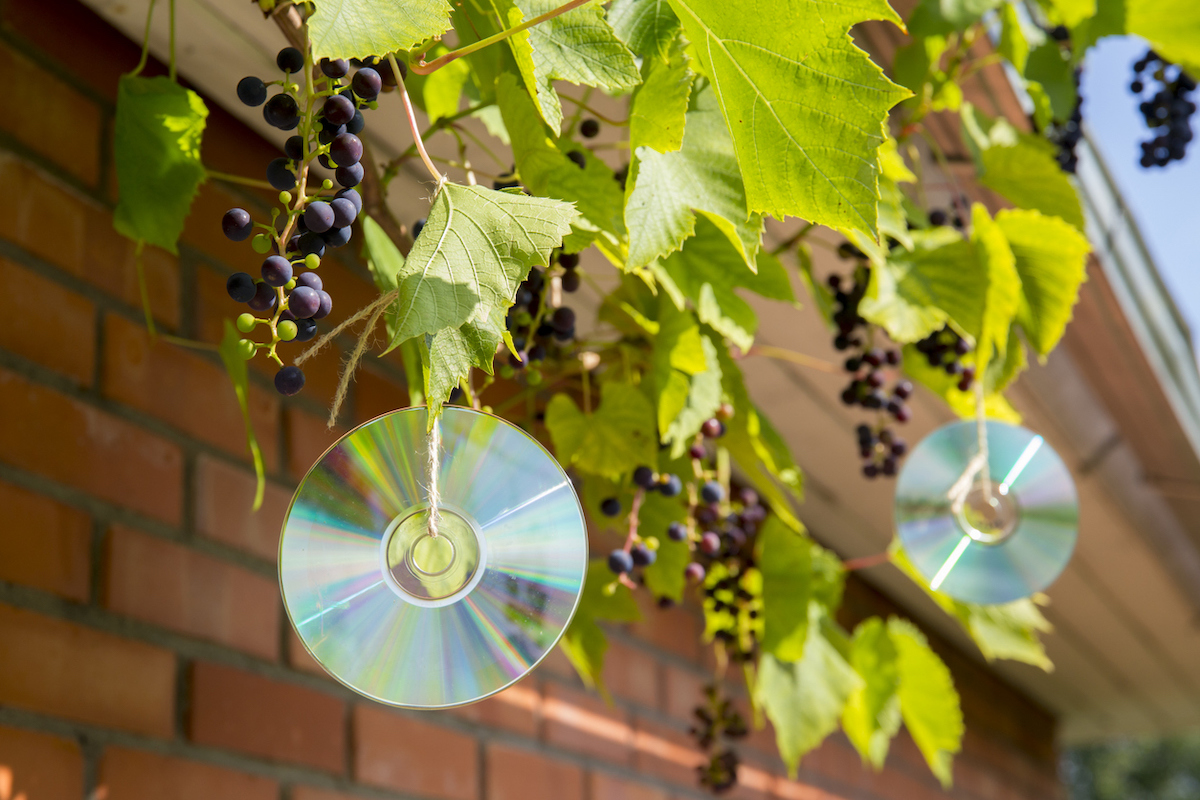

We may earn revenue from the products available on this page and participate in affiliate programs. Learn More ›
Gardeners understand the importance of inviting pollinators to their outdoor space, but they might not be so willing to share their carefully cultivated berries with the local and migratory birds in the area. Birds seem to have a knack for selecting the best, ripest, juiciest berries to nosh, leaving little harvest for humans.
Birds can eat as much as 80% of their body weight every day. This can impose a significant – and detrimental – impact on a berry patch, but there are humane ways to prevent hungry birds from ravaging your delicious fruits.
1. Netting

Bird netting is an inexpensive, simple way to protect prized berries from being plucked by voracious birds. Use stakes or poles to construct a frame for smaller blueberry bushes or low-growing strawberries, keeping the netting above the plants. For larger plants, like elderberries, or sprawling raspberry shrubs, drape netting over the entire bush.
Some fabrics can snag birds, particularly fledglings. Netting also makes harvesting difficult. “Look for netting with larger mesh sizes to prevent tangling and make it easier to access your berries,” says Jana McDaniel, founder of First Saturday Lime. Removing netting after the harvest isn’t always easy because it catches on twigs, thorns, and branches, causing tears.
2. Bagging

Similar to netting, bagging involves covering fruit with tulle, netting, mesh, or a comparable type of breathable fabric that allows sunlight, rain, and air to permeate but thwarts hungry birds from filching your fruit. This method can be particularly useful for protecting individual fruits on large trees (as opposed to netting the entire tree), grape clusters, or on trees and plants that don’t have a lot of berries. (Pictured above are YunKo’s 6 x 9 organza bags, sold in sets of 50.)
All the caveats regarding use of netting apply to bagging: snagging on branches, accidentally capturing birds, storage requirements. Add additional time and labor to fasten material to individual clusters of berries.
3. Crop cages

An alternative to netting and bagging that allows easier access for harvesting is the crop cage. These cages can be purchased or built DIY to form a complete structure over the whole plant while permitting air, rain, and sunlight to penetrate. Hoop cages can cover a raised bed and pop-up “tents” are best for small plants, while crop cages are ideal for taller individual plants and plants grown in containers. Crop cages are typically sturdy and their size can be customized, but one drawback is that they may prohibit pollinators from accessing the plant.
4. Cloches

A cloche – a small, translucent cover to protect plants – works best on small plants, such as strawberries. The cloche can cover the entire plant or just the berries of the plant. This is a labor-intensive and sometimes expensive option, due to the number of cloches needed for a sizeable berry patch, although it’s possible to upcycle water jugs, old bottles, or other inexpensive items. Because glass and plastic cloches trap heat and humidity – and prevent pollinators from reaching flowers – chicken wire cloches are a viable option to allow airflow and pollinator access while still protecting the berries.
5. Decoys

Although it adds character to a garden, the age-old decoy, the scarecrow, may be a futile attempt to chase away birds. A study in Oregon indicates that decoys work better when they look like predators. Plastic owls tend to be the most commonly used decoy, but setting black hose sections throughout the garden to mimic snakes is another low-cost option. No matter what is used as a decoy, birds typically become acclimated in just a few days. It can help to change location of the decoys every few days, but the birds will be on to your tricks soon enough.
6. Reflective deterrents

An old wives’ tale states that reflective surfaces, like aluminum foil, mirrors, mylar flash tape, pie pans, CDs, or DVDs will disorient birds. Stringing up CDs and DVDs can add motion as they move around when the wind blows, reflecting light as the sun shines off them. Aluminum foil might add noise to startle them … at first. “The flashing and movement from these objects can scare birds away,” McDaniel explains. Unfortunately, a study by the University of Nebraska indicates that there is little long-term benefit. Again, the birds quickly become acclimated and learn to ignore this tactic.
7. Movement

Whirligigs are little more than moving decoys. They can be as inexpensive as a shiny child’s pinwheel toy or a homemade wooden decoy with moving parts that resembles a predator. As with static decoys, moving them around every few days may keep birds guessing, but ultimately, birds will become accustomed to the devices and largely ignore them.
Motion-activated sprinklers are more effective in chasing away birds and other critters without doing any harm. While solar options are available (with battery storage for after-dark operation), a nearby water source is necessary. However, range is limited and they’re prone to electrocuting.
8. Auditory deterrents

“Playing recorded distress calls or predator sounds can frighten birds away,” McDaniel notes. However, you’ll need to vary the sounds and times they’re played to prevent habituation. You’ll also probably need access to electricity.
Windchimes combine the movement and shine of other decoys with the added “nuisance” of noise, but they depend on the wind blowing; on still days, they don’t produce any noise. As with most deterrents, birds quickly acclimate to sounds, but if routine noise becomes unpredictable, it can have some impact in scaring away the birds, even if only temporarily.
9. Rock berries

Fake ‘em out by painting rocks to look like berries. This method works best on strawberries because they grow on the ground, so it’s easy to strategically place red/painted rocks around the plants to fool birds.
This art project can become elaborate with detail or remain simple with just some red paint on a triangular rock. In order to “train” birds that there are no edible berries in your garden, start placing these fake strawberries around the plants before they produce real fruit. This is more effective with local birds than migratory birds, but most birds figure it out eventually.
10. Proper planting

McDaniel believes that companion planting can avert birds from nibbling your berries. “Certain plants, like herbs with strong scents, can help deter birds. Planting marigolds, lavender, or basil around your berry bushes may provide a natural deterrent.”
If your garden is more for aesthetic appeal than for crop-raising, plant species that birds won’t eat.
Another of McDaniel’s theories is that crop rotation can “hide” your berries from the birds, but it involves major gardening effort. “Consider rotating your berry crops to different areas of your garden each year; birds may be less likely to find and target your new berry patch location.”
11. Bird feeders

It may sound counter-intuitive to invite birds to your garden by putting up bird feeders, but if you provide irresistible delectables that delight a bird’s palate, they might bypass the berries in search of easier meals. Furthermore, once their bellies are full from the yummies in the birdfeeder, they won’t have room for berry dessert.
It’s important to determine the types of birds coming to your garden so you know what type of food will appeal to them. Grapes, oranges, cherries, peaches, plums, apples, and nuts entice different bird species. It’s also necessary to keep those feeders filled – which can become costly.
12. Sacrificial berries

Share. Plant extra for the birds to cover for losses in your harvest. It’s a risky move because the birds may still devastate your berry crop, but you might decide it’s more important to feed the birds than to frustrate them (and yourself) with deterrents. Use a combination of protective measures on part of your crop, leaving some sacrificial berries available for the birds. This could be the best of both worlds for all species. After all, not only are birds important pollinators, they also eat pesky garden insects.
